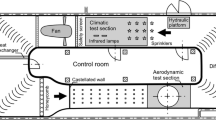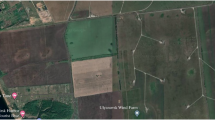Abstract
Accurate predictions of turbulent characteristics in the atmospheric boundary layer (ABL) depends on understanding the effects of surface roughness on the spatial distribution of velocity, turbulence intensity, and turbulence length scales. Simulation of the ABL characteristics have been performed in a short test section length wind tunnel to determine the appropriate length scale factor for modeling, which ensures correct aeroelastic behavior of structural models for non-aerodynamic applications. The ABL characteristics have been simulated by using various configurations of passive devices such as vortex generators, air barriers, and slot in the test section floor which was extended into the contraction cone. Mean velocity and velocity fluctuations have been measured using a hot-wire anemometry system. Mean velocity, turbulence intensity, turbulence scale, and power spectral density of velocity fluctuations have been obtained from the experiments for various configuration of the passive devices. It is shown that the integral length scale factor can be controlled using various combinations of the passive devices.






Similar content being viewed by others
Abbreviations
- κ :
-
von Kármán constant
- w :
-
Slot width
- d :
-
Displacement height
- f :
-
Frequency
- f s :
-
Vortex shedding frequency
- S t :
-
Strouhal number
- u ′ :
-
Fluctuating velocity in x-direction
- U :
-
Absolute velocity in x-direction
- \(\overline{U}\) :
-
Mean velocity in x-direction
- \(\overline{U}_z\) :
-
Mean velocity in x-direction at height z
- u ∗ :
-
Shear velocity
- \(\overline{U}_{\rm ref}\) :
-
Reference velocity
- \(\overline{U}_{\delta}\) :
-
Freestream velocity
- x :
-
Distance in the direction of the flow
- y :
-
Spanwise distance from test section centerplane
- z :
-
Vertical distance from wind tunnel floor
- z ref :
-
Reference height
- z 0 :
-
Aerodynamic surface roughness length
- Lu x :
-
Longitudinal integral length scale of turbulence
- Ru x :
-
Longitudinal auto-correlation coefficient
- S :
-
Length scale factor
- P uu (f):
-
Power spectrum of longitudinal velocity fluctuations
- α :
-
Power law exponent
- δ :
-
Boundary layer thickness
- σ u :
-
Standard deviation of u
- ν :
-
Air viscosity
- A F :
-
Frontal area of all passive devices
- A T :
-
Total surface area
- λ F :
-
Frontal area density
- m :
-
Model
- p :
-
Prototype
References
Akins RE, Cermak JE (1976) Wind pressures on buildings, fluid dynamics and diffusion laboratory. Report CER76-77REA-JEC15, Colorado State University, Fort Collins
Cook NJ (1978a) Determination of model-scale factor in wind-tunnel simulations of the adiabatic boundary layer. J Wind Eng Ind Aerodyn 2(4):311–321
Cook NJ (1978b) Wind-tunnel simulation of adiabatic atmospheric boundary layer by roughness, barrier and mixing device method. J Wind Eng Ind Aerodyn 3:157–176
Counihan J (1969) An improved method of simulating an atmospheric boundary layer in a wind tunnel. Atmos Environ 3:197–214
Counihan J (1971) Wind tunnel determination of the roughness length as a function of the fetch and the roughness density of three-dimensional roughness elements. Atmos Environ 5:637–642
Counihan J (1973) Simulation of an adiabatic urban boundary layer in a wind tunnel. Atmos Environ 7:673–689
Counihan J (1975) Adiabatic atmospheric boundary layers: a review and analysis of data from the period 1880–1972. Atmos Environ 9:871–905
Cramer A, Varshney K, Gundrum T, Gerbeth G (2006) Experimental study on the sensitivity and accuracy of electric potential local flow measurements. Flow Meas Instrum 17:1–11
Davenport AG, Isyumov N (1967) The application of atmospheric boundary layer wind tunnel to prediction of wind loading, wind effects on buildings and structures. University of Toronto Press, Ottawa, pp 210–230
ESDU Data Item No. 72026 (1972) Characteristics of wind speed in lower layers of atmospheric near the ground: strong winds—natural atmosphere. Engineering Science Data Unit, London
ESDU Data Item No. 74030, 74031 (1974–1975) Characteristics of atmospheric turbulence near the ground. Engineering Science Data Unit, London
ESDU Data Item No. 85020 (1985) Characteristics of atmospheric turbulence near the ground. Engineering Science Data Unit, London
Farell C, Iyengar AKS (1999) Experiments on the wind tunnel simulation of atmospheric boundary layers. J Wind Eng Ind Aerodyn 79:11–35
Jensen M (1958) The model law phenomena in natural wind. Ingenioren 2(4):121–128
Kaimal JC, Finnigan JJ (1994) Atmospheric boundary layer flows: their structure and measurement. Oxford University Press, New York
Kozmar H (2010) Scale effects in wind tunnel modeling of an urban atmospheric boundary layer. Theor Appl Climatol 100:153–162
Nishioka M, Sato H (1974) Measurements of velocity distributions in the wake of a circular cylinder at low Reynolds numbers. J Fluid Mech 65(1):97–112
Pasquill F (1967) Wind structure in the atmospheric boundary layer. Discuss on Archit Aero Phil Trans R Soc A 269:321–554
Perry AE, Joubert PN (1963) Roughness boundary layers in adverse pressure gradients. J Fluid Mech 17:193–221
Reinhold TA, Tieleman HW, Maher FJ (1978) Simulation of the urban neutral boundary layer for the model study of wind loads on tall buildings. Report VPI-E-77-12. Department of Engineering Science and Mechanics, Virginia Polytechnic Institute and State University, Blacksburg
Sax MJ (1978) Fluctuating pressure field on a Yawed rigid cylinder. Ph.D. thesis, Graduate School of The University of Minnesota, Minnesota
Tieleman HW, Reinhold TA, Marshall RD (1978) Wind tunnel simulation of atmospheric surface layer for the study of wind loads on low-rise buildings. J Wind Eng Ind Aerodyn 3(1):21–38
Varshney K, Panigrahi PK (2005) Artificial neural network control of a heat exchanger in a closed flow air circuit. Appl Soft Comput 5:441–465
Acknowledgements
The authors are thankful for the financial support provided by the Aerospace Engineering Department, Indian Institute of Technology, Kanpur. We express our thanks to the technical staff of the department for manufacturing simulation hardware used in this study.
Author information
Authors and Affiliations
Corresponding author
Rights and permissions
About this article
Cite this article
Varshney, K., Poddar, K. Experiments on integral length scale control in atmospheric boundary layer wind tunnel. Theor Appl Climatol 106, 127–137 (2011). https://doi.org/10.1007/s00704-011-0415-y
Received:
Accepted:
Published:
Issue Date:
DOI: https://doi.org/10.1007/s00704-011-0415-y




